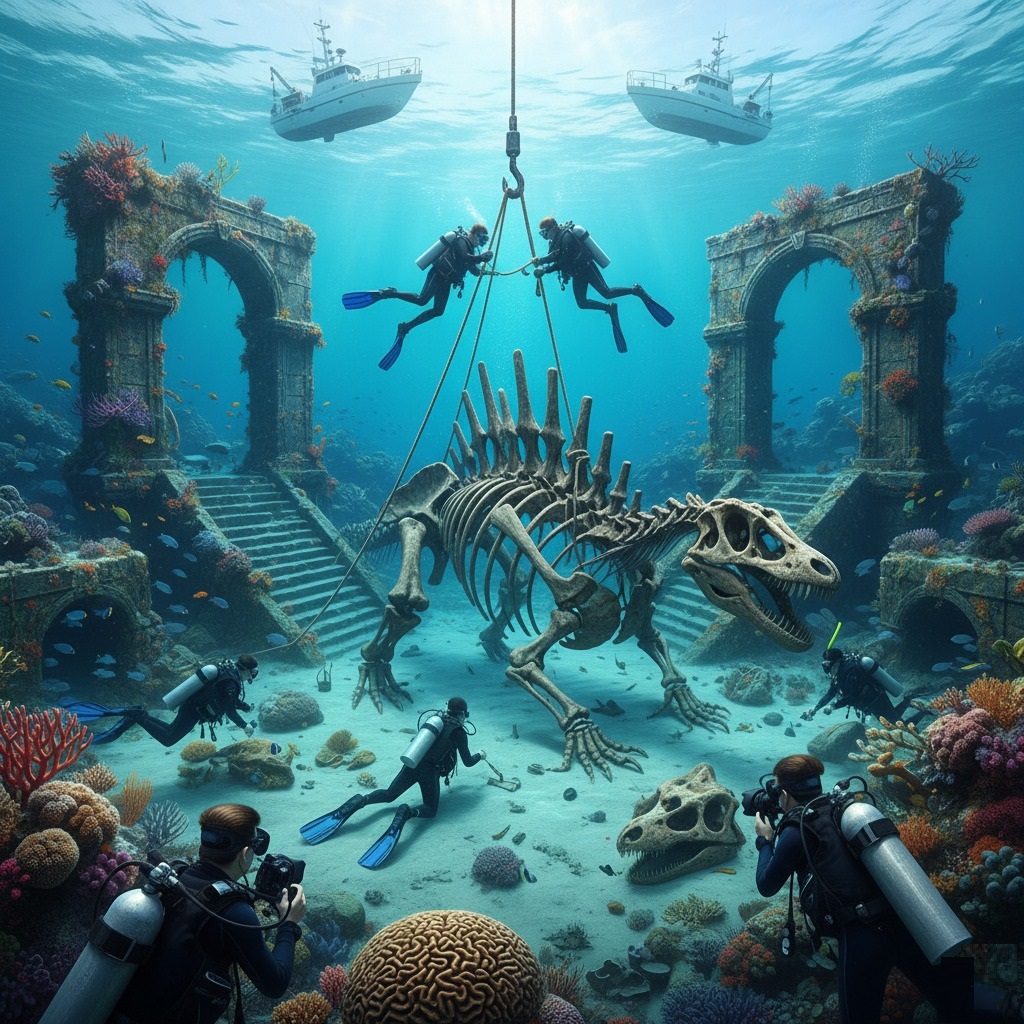Unearthing Giants: The Lost Spinosaurus of the Yonaguni Monument

The year was 2042. Dr. Aris Thorne, a marine paleontologist whose name was synonymous with impossible discoveries, adjusted his rebreather. Below him, the cyan waters of the East China Sea swirled with the ghosts of forgotten ages. His expedition had been targeting anomalies near the Yonaguni Monument, the colossal underwater rock formation off the coast of Japan, long debated as a natural phenomenon or a man-made pyramid. Aris, however, suspected something far older, far grander.
For decades, sonar scans had hinted at structures beyond the known monument, deep beneath the treacherous currents. Today, those hints had materialized into a reality that defied every textbook. As Aris descended, the familiar terraced steps and sharp angles of Yonaguni faded, replaced by something even more astonishing. Submerged under millennia of sediment, not another man-made ruin, but a scattering of colossal, weathered stone arches and cyclopean staircases emerged from the gloom. These were unlike any architecture he’d ever seen – older, simpler, yet imbued with an undeniable grandeur that whispered of a forgotten civilization swallowed by the sea.
But it wasn’t the stones that made his heart pound. It was the leviathan cradled within them.
There, spanning the entire width of a forgotten plaza, lay the impossibly preserved skeleton of a Spinosaurus. Its immense dorsal sail, a signature of the ancient predator, was largely intact, rising like a jagged spine from the seabed. The skull, massive and crocodilian, lay detached but perfectly preserved nearby, its terrifying teeth still gleaming faintly. Around it, the team of divers, a ballet of bubbles and purposeful movement, were meticulously clearing sediment and attaching heavy-duty rigging to key sections of the beast.
“Status report, Dr. Thorne,” crackled his comms, the voice of Captain Elena Petrova, their lead archaeologist, cutting through the awe.
“It’s… it’s magnificent, Elena,” Aris breathed, swimming closer to one of the giant vertebrae, encrusted with ancient corals. “The preservation is unprecedented. And these structures… they’re not like Yonaguni. They predate it. This entire area was a shallow coastal plain, perhaps even a freshwater lake, when this creature roamed.”
Elena’s voice was tinged with wonder. “The dating suggests these ruins are from the late Cretaceous, Aris. Roughly 70 to 80 million years ago. If this Spinosaurus was entombed here, it means this was once a prime hunting ground, possibly the very edge of the ancient Asian continent, before the tectonic plates shifted and the sea claimed it all.”
The implications were staggering. Not only had they found a nearly complete Spinosaurus, but it was nestled within a ruin thousands, if not millions, of years older than any known human civilization. Was this a natural burial site, or had some unknown, non-human intelligence arranged it? The idea was preposterous, yet the symmetrical placement of the ruins, the way the dinosaur seemed almost displayed, gnawed at Aris.
Days turned into weeks. The surface vessels hummed with activity, their colossal crane slowly, painstakingly, raising sections of the skeletal giant. Each bone brought to the surface was a triumph, a fragment of a lost world. But it was the final lift, the massive skull, that revealed the deepest mystery. Embedded just above the creature’s eye socket, not a fossilized weapon, but a perfectly smooth, obsidian-like sphere, about the size of a human fist. It pulsed with a faint, almost imperceptible blue light.
The discovery sent shockwaves through the scientific community. The “Yonaguni Anomaly,” as the sphere was dubbed, defied all known geological or biological explanations. It was undeniably artificial, yet impossibly ancient, predating not just humanity, but the very mammals that would eventually inherit the Earth.
Standing on the deck of the research vessel, watching the sun set over the vast, enigmatic Pacific, Aris clutched the data tablet detailing the anomaly. The Spinosaurus was a giant unearthed, a window into the planet’s ferocious past. But the sphere… that was something else entirely. It was a whisper from a time when the Earth might have held secrets far stranger, far more profound, than even the most imaginative paleontologist could dream. The Yonaguni Monument had always been a mystery, but now, beneath its shadow, an even greater one had been discovered, challenging not just the timeline of life, but the very definition of intelligence itself. The lost Spinosaurus had not merely been found; it had become the key to a door nobody knew existed.
